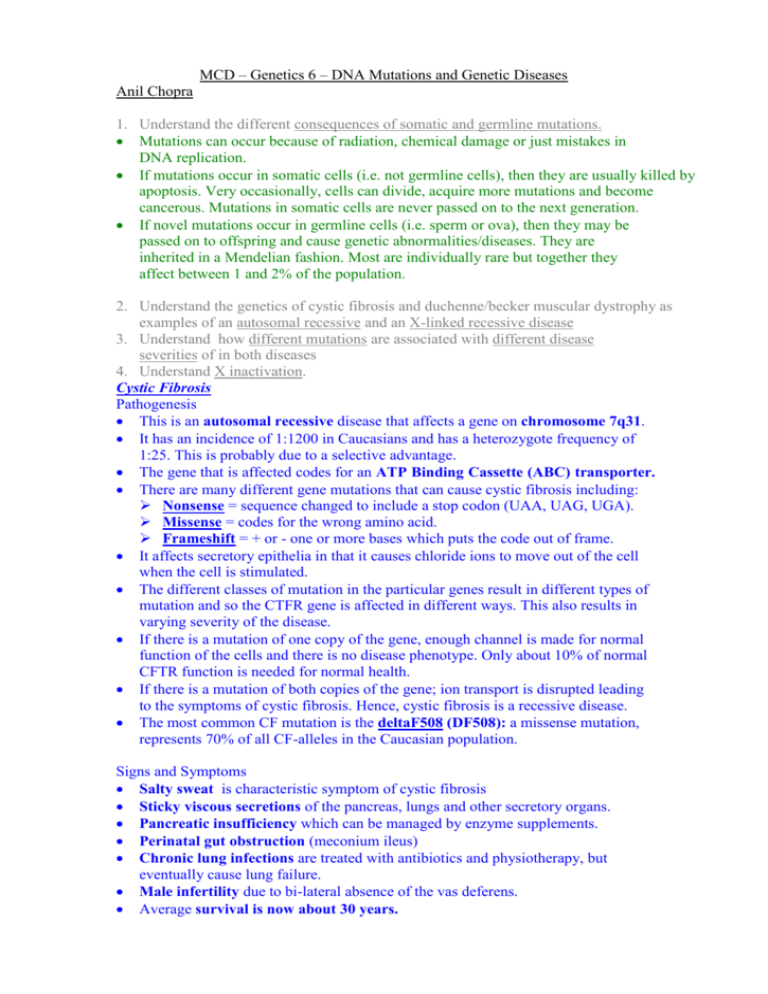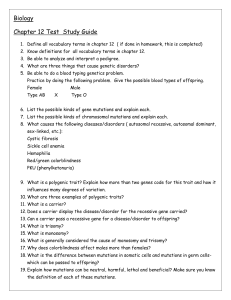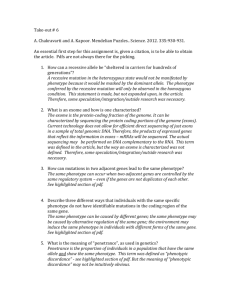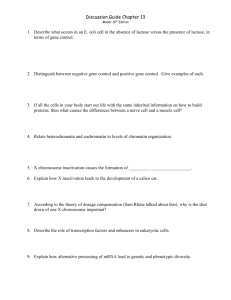Genetics 6 – DNA mutations and Genetic Diseases
advertisement

MCD – Genetics 6 – DNA Mutations and Genetic Diseases Anil Chopra 1. Understand the different consequences of somatic and germline mutations. Mutations can occur because of radiation, chemical damage or just mistakes in DNA replication. If mutations occur in somatic cells (i.e. not germline cells), then they are usually killed by apoptosis. Very occasionally, cells can divide, acquire more mutations and become cancerous. Mutations in somatic cells are never passed on to the next generation. If novel mutations occur in germline cells (i.e. sperm or ova), then they may be passed on to offspring and cause genetic abnormalities/diseases. They are inherited in a Mendelian fashion. Most are individually rare but together they affect between 1 and 2% of the population. 2. Understand the genetics of cystic fibrosis and duchenne/becker muscular dystrophy as examples of an autosomal recessive and an X-linked recessive disease 3. Understand how different mutations are associated with different disease severities of in both diseases 4. Understand X inactivation. Cystic Fibrosis Pathogenesis This is an autosomal recessive disease that affects a gene on chromosome 7q31. It has an incidence of 1:1200 in Caucasians and has a heterozygote frequency of 1:25. This is probably due to a selective advantage. The gene that is affected codes for an ATP Binding Cassette (ABC) transporter. There are many different gene mutations that can cause cystic fibrosis including: Nonsense = sequence changed to include a stop codon (UAA, UAG, UGA). Missense = codes for the wrong amino acid. Frameshift = + or - one or more bases which puts the code out of frame. It affects secretory epithelia in that it causes chloride ions to move out of the cell when the cell is stimulated. The different classes of mutation in the particular genes result in different types of mutation and so the CTFR gene is affected in different ways. This also results in varying severity of the disease. If there is a mutation of one copy of the gene, enough channel is made for normal function of the cells and there is no disease phenotype. Only about 10% of normal CFTR function is needed for normal health. If there is a mutation of both copies of the gene; ion transport is disrupted leading to the symptoms of cystic fibrosis. Hence, cystic fibrosis is a recessive disease. The most common CF mutation is the deltaF508 (DF508): a missense mutation, represents 70% of all CF-alleles in the Caucasian population. Signs and Symptoms Salty sweat is characteristic symptom of cystic fibrosis Sticky viscous secretions of the pancreas, lungs and other secretory organs. Pancreatic insufficiency which can be managed by enzyme supplements. Perinatal gut obstruction (meconium ileus) Chronic lung infections are treated with antibiotics and physiotherapy, but eventually cause lung failure. Male infertility due to bi-lateral absence of the vas deferens. Average survival is now about 30 years. Treatment Classical Genetic Linkage by disease phenotype inheritance: For example: Colour-blindness and Haemophilia in male decedents. Molecular Linkage analysis: Follow inheritance of the disease and about 300 DNA markers (Restriction Fragment Polymorphisms (RFP), Small Nucleotide Polymorphisms (SNPs) over several generations in many families. A marker which segregates with the disease is positioned near by its location on the chromosome. You can find the gene responsible for ANY genetically determined phenotype using molecular linkage analysis. No cure Enzyme replacement, physiotherapy, antibiotics, DNase I treatment Heart lung transplant Duchene Muscular Dystrophy This is a severe progressive generalised myodegenerative disease. It is an X-linked recessive disease meaning that: If any males are affected they show phenotype. If females are homozygous then they show phenotype. If females are heterozygous (carriers) then they show no phenotype HOWEVER – during development, the first 1000 cells, BOTH Xchromosomes are expressed equally, then they are expressed randomly in different cells, therefore clinical phenotype may occur in varying degrees if the female is heterozygous. It is the dystrophin gene on Xp21 that is affected. This encodes for the cytoskeletal protein dystrophin which maintains muscle integrity. The dystrophin gene has one of the highest mutation rates in humans – whole exons are usually removed. It occurs between the ages of 2 and 5 and causes muscle weakness. This results in difficulty running and later, walking up stairs. Most patients are in a wheelchair by the age of 11 and dead by the age of 20 due to respiratory infections/ difficulties as a result of degeneration of the intercostal muscles. BMD (Becker Muscular Dystrophy) is a more benign allelic disease: Age of onset ~12 years - much longer survival. Some dystrophin is found in their muscles and so they are able to walk up until the age of 16. Disease results in Fibre necrosis (seen in all postnatal muscle biopsies even before muscle weakness is observed clinically) Phagocytosis of necrotic fibres (muscle biopsy reveals presence of inflammatory cells) In early stages of dystrophinopathies - active regeneration of muscle to replace/repair lost or damaged fibres Exhaustion of eplicative capacity of satellite cells (muscle stem cells) and muscle fibre replacement by fat and connective tissue - muscle atrophy. 5. Understand the importance of genetics for diagnosis and treatment of genetic disease and disease caused by genetic factors • Determine the molecular basis inherited diseases • Design drugs for treatment • Genetic testing • Prenatal testing • Gene therapy









